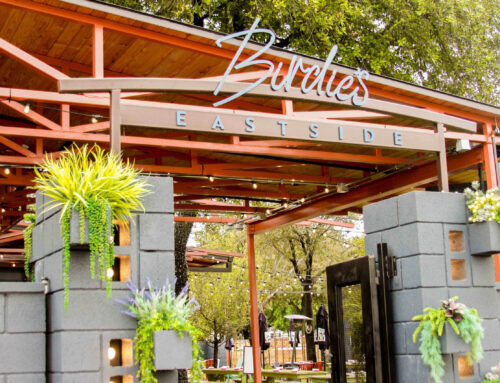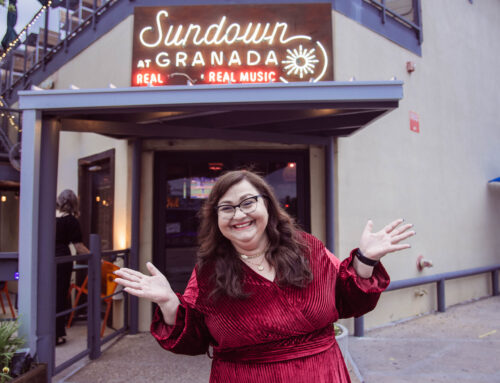They Are Leading the Lonely Fight Against Neighborhood Crime. And They Ask a Simple Question: Why Won’t the Rest us Help?
We finally seem to be getting the message that crime isn’t just a police problem – it’s our problem, too. And we seem to be getting another message: Escaping to the suburbs won’t end our crime problem. Just ask the people in Richardson. Or Plano. Or Garland. Or…
Simply put, no city or neighborhood is immune from crime, so moving away won’t keep us safe. And cowering behind electronically protected walls, with loaded weapons across our laps, doesn’t exactly conjure visions of the ‘good old days’ of Lassie, Andy Griffith and the Waltons.
Unless we band together and take actions as neighborhoods, our crime problem won’t go away.
Some East Dallas and Lakewood residents are shaking off the apathy that only serves to encourage criminals. They are taking the lead, asserting themselves through their Neighborhood Crime Watch.
Here are the stories of neighbors who are making a difference.
Harry Lautz lived in his little house on Glasgow Street for 31 years before the neighborhood gangsters began to aim their guns in his direction.
During the past four years, Lautz says, the bad guys have shot at him or his wife eight times. The first incident involved a 13-year-old with a rifle. Another time, a 17-year-old member of the Eastside Locos, later killed in a high-speed police chase, fired a handgun at Harry in full view of the youth’s mother.
Last year, someone fired a shotgun over Mrs. Lautz’s head while she raked leaves under the magnolia tree in her yard. Mrs. Lautz doesn’t go outside much anymore, her husband says.
The gangsters know that Lautz knows where they live. And the would-be burglars and the customers of the drug dealers and prostitutes who dare to operate within Junius Heights, a neighborhood of 750 homes below Lakewood, are learning to look out for Lautz and his fellow Crime Watch members.
“I’m scared, I’m disgusted, and I’m frustrated, that’s what I am,” says Lautz, a native of Pittsburgh, Pa., who moved to Dallas in 1948 and worked for many years as an airline mechanic.
“I was figuring on being retired. I never figured I’d be getting into this kinda fun.”
Junius Heights is characteristic of lower East Dallas with its broad residential mix that run from trash-strewn empty lots to stately old homes, and just about everything in between.
When he first arrived in Dallas, Lautz, 67, didn’t have to spend three hours on a weekday morning walking door to door in a cold rain to drop off monthly Crime Watch fliers.
Today, he’s seeking a semblance of the quiet community where his son walked to school and a lady could rake leaves in her yard, for gosh sakes, without getting shot at.
“I’m with Crime Watch reluctantly. I do it to protect my wife and my property. I do not do it cheerfully,” he says.
The criminals are bold, and Crime Watch requires law-abiding citizens whose first impulse may be to sit and negotiate to instead demonstrate reciprocal nerve.
But standing up to criminals is just what people must do to protect their neighborhoods, says Cpl. Rick Janick of the East Dallas police storefront on Peak Street. “We need strong individuals to keep Crime Watch Groups motivated. You can have a lot of people in your Crime Watch, but if they don’t get involved and keep it active, they’re doomed to failure,” Janick says.
But standing up to criminals is just what people must do to protect their neighborhoods, says Cpl. Rick Janick of the East Dallas police storefront on Peak Street. “We need strong individuals to keep Crime Watch groups motivated. You can have a lot of people in your Crime Watch, but if they don’t get involved and keep it active, they’re doomed to failure,” Janick says.
Each resident responds in his own way – and for his own reasons.
The president of Junius Heights Crime Watch, although she works actively behind the scenes to help neighboring communities with their crime-fighting efforts, requests anonymity, fearing gang reprisals.
Others in the neighborhood welcome the attention, hoping it can help make a difference.
Mary Carroll is an energetic, urban rehab advocate who owns two dozen houses in the community, mostly rented to young, professional people. She’s lived in Junius Heights for 41 years.
Craig McDaniel, another member of Junius Heights’ informal Crime Watch patrol, owns some apartment buildings in the area. He’s also targeting Lori Palmer’s City Council seat, which she will vacate after the elections this spring.
“Anybody who works for me, their assigned duty is to watch out for suspicious people,” says Carroll, who has helped police make several arrests.
“The police tell me I catch more criminals than they do.”
Junius Heights Crime Watch employs such tools as voice mail, which allows a monitor to leave crime alert messages for residents and callers to report suspicious activity (police recommend that people first call 911).
The neighborhood also hires off-duty police officers to work three four-hour shifts a week at $25 per hour.
Thanks in large part to the group’s efforts, McDaniel says, crime in Junius Heights has declined by 50 percent during the past two-and-a-half years.
He recommends residents get to know the officers who regularly patrol their streets each day.
“There’s a side benefit to having an aggressive Crime Watch,” says McDaniel, who works as a public relations consultant.
“Officers usually deal with the rats of society. With neighborhood Crime Watch, they’re exposed to a lot of good, friendly people. And if they’re more disposed to driving down this street, that’s fine.
“I like living here now more than I did seven years ago. Like many others in this part of town, this neighborhood could go either way.
“Our success is a result of our commitment to clean up properties and be aggressive in dealing with such issues as code enforcement and drug use.”
Still, Lautz says only about 100 families contribute financially to Crime Watch, and just 60 pay the full $25 a month fee that helps fund off-duty police patrols.
“We have a lot of so-called nice people here,” he says. “They don’t make the monthly contributions, they don’t come to the meetings, they don’t help us to do any of the work.
“I used to deliver the newsletters on Saturday afternoon. But everybody’s home on Saturday. And when they see me, they come running out of their houses and they say: ‘We got this problem, we got that problem. Why don’t you do something about it?’
“Well, our crime watch is not an official department of the City of Dallas. It’s just little guys. We’re like a union. It’s the little guys got together because things got so bad here.”
Lautz joined the Navy at the start of World War II and picked up his first ship in Orange, Texas. He chased submarines across the Atlantic and saw the movie “Casablanca” for the first time while docked in that very city in North Africa.
“I liked what I saw down here, and after the war, I said: ‘I’ll go back down to Texas. I want to see some real cowboys,” Lautz says.
“I came here on Greyhound, got to talking to a supervisor and went to work greasing buses at the station on Cadiz Street.”
That led to jobs at American Airlines and Braniff (with two more years out for the Korean War) and the house on Glasgow.
“Back then, this was a nice city. Clean and quiet. I loved it. That’s why I stayed,” he says.
But even with Crime Watch, things aren’t so nice now, Lautz says. He registered to vote for the first time only last year so he could sign a petition supporting pay raises for Dallas police.
“Four or five years ago, I saw these little kids take a rifle over to the house where one of the troublemakers, a 13-year-old kid, lived. It was broad daylight. About two, three minutes later, he gets to shooting.
“Well, I know the father drinks in a beer joint on Columbia. He’s not any help. So I go over to the house and say: ‘Son, don’t shoot that gun. You’re not allowed to shoot in the City limits.’
“I’m standing on the sidewalk, and he’s on his front porch. He says: ‘You can’t tell me what to do,’ and he puts a round right between my feet.”
The boy is about 18 by now, still making trouble, and well known by police anti-gang officers. But McDaniel insists the homeowners are forcing the criminals out.
“We have cleaned out our neighborhood,” he says. “Crime Watch is directly responsible for a lot of that. It empowers the people who usually cower behind their closed Venetian blinds.
“If you know other people in the neighborhood are getting out to do something about crime, you’re more likely to get involved, too.”
‘Nosy Neighbors’ Are the Best Antidote to Crime in the Community
Assistant Chief Marvin Bullard of the Dallas Police Department says: “Few offenses occur that somebody doesn’t know something about. If the police department knew what you know,” Dallas could sharply reduce its crime problem.
Yet, when members of the now-arrested “phone line gang” shot a resident of the Caruth Meadows neighborhood in East Dallas on the night of Dec. 3, as police suspect, none of his neighbors seemed to hear the incident.
Even when the gang returned hours later to the man’s house and drove his car through the kitchen wall and then burglarized the place, neighbors apparently failed to notice.
The phone line gang operated for weeks out of a house on McCommas Boulevard in the Lower Greenville neighborhood before a neighbor finally turned them in to police.
“Our daughter kept telling her dad and me how weird they were,” says Patty Smith, who lives across the street from arrested phone line bandit Karl Anderson.
“But we just told her to mind her own business.”
Meanwhile, Caruth Meadows residents, who were in the process of reviving their Crime Watch when burglars struck seven times within a two-week period after Thanksgiving, are trying to put such attitudes behind them.
The quiet neighborhood of 520 homes, many occupied by older people, is located south of Lovers Lane, between Skillman and Abrams roads. When Reena Morris called an initial meeting in October, about 125 people appeared.
Still, the burglaries seemed to hit them off-guard.
“We were in the process of appointing our Crime Watch block captains and section coordinators when the burglaries happened,” says Luther Terry, the group’s co-director.
“We had some people who were reluctant to participate,” says Terry, who retired two years ago from E-Systems, where he was assistant corporate secretary.
“They didn’t have anything against the idea. They just hadn’t had any problems, and they weren’t too interested.
However, “I would say we have a bunch of alert people at this point,” Terry says.
Luther and Jeane Terry moved to their home in Caruth Meadows on May 10, 1964 (a date Jeane recalls without hesitation), and found the local elementary school, Dan D. Rogers, to be a focal point for the neighborhood.
But they say busing sent the local kids elsewhere and caused the neighborhood to change. Young families stopped moving in, and people were less social. Rising crime also made people more cautious.
“This is a change I’ve had to make by living in a big city,” says Jeane Terry, who grew up in the west-central Texas town of Eastland.
“It creates a kind of free-floating anxiety. We’ve been here 42 years, and it seems like the character of the City has changed.”
Terry says: “Personally, I’m a lot more vigilant than I ever was before. I lock my doors, lock my car and do whatever I can to prevent burglaries.”
As members of Crime Watch, they’re getting to know their neighbors again, too. Block parties bring residents together. Neighbors also fill out charts provided by police that show houses and alleys around every house and phone numbers and addresses for each resident.
“To me, the most successful part of one of these things is having nosy neighbors,” Terry says. He cautions, however, that a low-key approach will probably work best for Crime Watch.
“Don’t do too much, but do it well. I don’t believe the neighbors will find time for a lot of meetings,” he says. “What we do hope to accomplish is to get people to visit with each other, know who their neighbors are and by nosy.”
Crime Watch Requires New Tactics Now, Says Activist Pam Stephenson
If City Hall and its politicians think awards and words of praise will make a team player out of Crime Watch activist Pam Stephenson, they’d better try some new tactics – such as following through on their own anti-crime programs.
In fact, Stephenson, who last month received the Crime Watch Achievement Award and protracted words of praise from Council members and Mayor Steve Bartlett, is moving toward community-based initiatives that bypass the City entirely.
Stephenson is an insurance agent and Crime Watch chairman of the Vickery Place Neighborhood Association, which represents a culturally mixed community of 1400 homes between Central Expressway and Lower Greenville Avenue.
Typically, some Vickery Place residents keep their homes nice and neat, while others park cars on their front lawns.
Through the efforts of the neighborhood group, which celebrated its 11th anniversary in January, as well as an active Crime Watch, the community has protected its modest real estate values and maintained a relatively safe environment for residents.
Such events as a monthly neighborhood walk, an anti-litter “Alley Rally” and a Crime Watch Carnival promote a sense of community that helps the neighborhood association wield modest political clout downtown.
Stephenson and other Crime Watch members also keep close ties with the police officers who patrol their neighborhood. They deliver snacks every month to the officers at Central Patrol on Canton Street and attend East Dallas Crime Coalition meetings at the police storefront on Peak Street.
So why, when one vagrant killed another in the vacant house next door to Stephenson in 1990, did she have to read about it in the newspaper?
She says police fail to disseminate information on breaking crime and crime trends to the 932 Crime Watch groups throughout the City.
“Crime Prevention officers will come out from their station in the West End and help neighborhoods set up Crime Watch programs,” Stephenson says.
“But they do nothing to monitor ongoing Crime Watch groups. On a day to day basis, they are not preventing crime.”
Stephenson angered police officials when she complained in a letter last July that the department has failed to adequately promote the civilian Volunteers in Patrol program.
But months later, police have still conducted only two VIP classes, at the North Central substation, with plans for one more at the Southwest substation.
Further, Stephenson has gained little satisfaction from her involvement in the Texas City Action Plan to Prevent Crime, an eight-city initiative that began in September.
Bartlett is the only so-called “Muscle Mayor” from the eight cities who has declined to attend local T-CAP meetings, including the most recent Dallas T-CAP meeting Jan. 12 at the Northeast substation, which did attract Dallas Police Chief William Rathburn.
Stephenson has expressed her appreciation for the East Dallas storefront officers who support area Crime Watch groups, and they have returned the compliment.
Sgt. Jim Little of the storefront nominated Stephenson for the Crime Watch Achievement Award and escorted her to the award ceremony.
But Crime Watch requires a wider perspective now, Stephenson says, a “Phase II” that will bring all of the groups together. She’s hoping to organize a citywide Crime Watch meeting in February or March.
“I want us to be a community-driven initiative. That’s not to exclude the police department and the politicians, but we want to be hosting it,” she says.
“I want to keep Crime Watch going block by block, neighbor by neighbor. But I also want a second tier where East Dallas can hook into the good ideas that groups in North, South and West Dallas are using.
“We’ve been organized for two or three years now,” Stephenson says. “This is the next step.”





